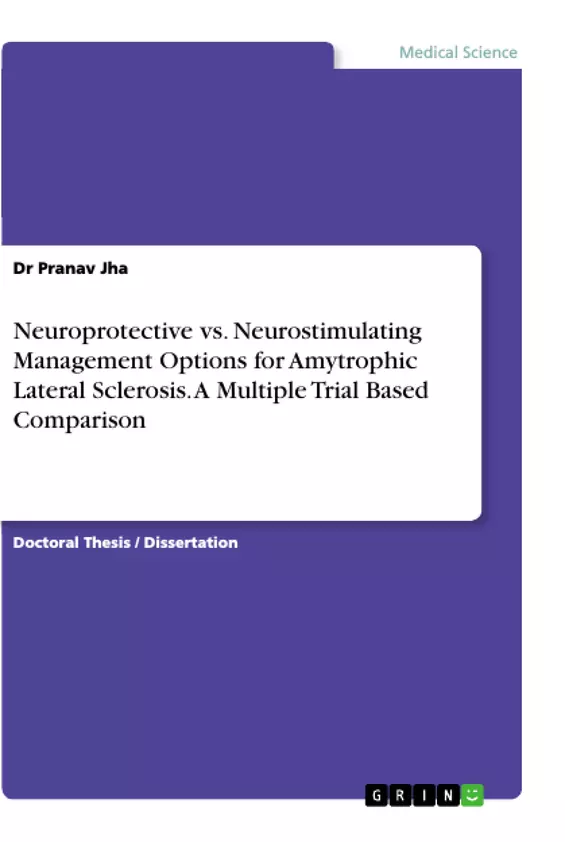ALS, an incurable fatal syndrome (than being just a misnomer of disease), affecting each organ system and life (quality and quantity), through glutamate induced free radical and electrical injuries to nerves. This giant needs to be further dig into, with deeper investigations for newer management options and betterment of previous treatments, aiming a comparison of various strategies, to invent most sustainable and suitable choice for PALS.
Broadly ALS can be classified as sporadic and familial, based on aetiology. There are various subtypes in each of them with regard to the genetic, pathological and nucleic acid mutational conflicts. Like in a case of “Diabetes Mellitus”, we don’t haphazardly enlist all drugs and precautions, instead first classify them into pharmaco-therapeutic or lifestyle changes, similarly for ALS, I’ve proposed for a new management classification system for clinical purposes after feeling a need of such, near the end of dissertation. Only approved and unavoidable option in present scenario is glutamic acid release inhibitor
“Riluzole” and the basic or standard life care for the disease. Broad spectrum antibiotic “Ceftriaxone” has been found to cross the blood brain barrier and increase GLT-1 channel, leading to fall in glutamate levels of nervous system and hence can be an add-on option to benefit more. RPPX: Dexpramipexole; recently developed drug especially for SOD-1 and TDP-43 mutation ALS, showed mitochondrial protection and reciprocated it as improved ALSFRS. Though the medication can be a future option, but for now trials have failed to reflect major benefit on a 12-month follow up.
MCI186: Edaravone, by virtue of being antioxidant in character (supposedly); has gained FDA approval in 2017 due to promising results. Drug has been in use in USA since May 2017 and will be introduced in European market following political, copyright and legal decisions in time. Tirasemtiv activates muscle troponin complex leading to increased sensitivity of neuromuscular junction (NMJ) for calcium (Ca2+) and hence help to overcome the fatigue of ALS. Study is yet undergoing with biggest hope amongst all newer options. DPS using local electrodes in diaphragm, overcome respiratory efforts in ALS affected patients. Being an “HDE” due to dramatic symptomatic relief, it’s being considered in guidelines, even after multiple failed trial results on 12 month follow up and absolutely no effect on survival and disease progression.
Inhaltsverzeichnis (Table of Contents)
- TITTLE PAGE
- ACKNOWLEDGEMENT(s)
- TABLE OF CONTENT(S)
- ABBREVIATION(s)
- ABSTRACT
- CHAPTER 1: GENERAL INTRODUCTION
- Dissertation Methodology
- Aims and Objectives
- Introduction
- CHAPTER 2: MAJOR NEURO-PROTECTIVE METHODS
- Literature Review on Controlled Trial of Riluzole in Amyotrophic Lateral Sclerosis
- Introduction
- Material and Methods
- Randomization and Criteria
- Figures
- Results
- Literature Review on Clinical trial with ceftriaxone in amyotrophic lateral sclerosis
- Introduction
- Material and Methods
- Randomization and Criteria
- Figures
- Results
- Literature Review on Randomised, Double-Blind, Placebo-Controlled, Study of Safety and
Efficacy of Dexpramipexole in Subjects with ALS
- Introduction
- Material and Methods
- Randomization and Criteria
- Figures
- Results
- Literature Review on Efficacy and Safety of MCI-186 Edaravone
- Introduction
- Material and Methods
- Randomization and Criteria
- Figures
- Results
- Literature Review on Controlled Trial of Riluzole in Amyotrophic Lateral Sclerosis
- CHAPTER 3: MAJOR NEURO-STIMULATIVE METHODS
- Literature Review on CY4031-VITALITY-ALS (TIRASEMTIV)
- Introduction
- Material and Methods
- Randomization and Criteria
- Figures
- Results
- Literature Review on Multi-Centre, Randomised Controlled Study of NeuRx® Diaphragm
Pacing System™ In Participants with A LS
- Introduction
- Material and Methods
- Randomization and Criteria
- Figures
- Results
- Literature Review on Repetitive Transcranial Magnetic Stimulation (rTMS) in ALS
- Introduction
- Material and Methods
- Randomization and Criteria
- Figures
- Results
- Literature Review on CY4031-VITALITY-ALS (TIRASEMTIV)
- CHAPTER 4: CRITICAL ANALYSIS
- CHAPTER 5: CONCLUSIONS and FUTURE SCOPES
- Conclusions
- Future Scope
- CHAPTER 6: REFERENCES
Zielsetzung und Themenschwerpunkte (Objectives and Key Themes)
This dissertation explores the various management options for Amyotrophic Lateral Sclerosis (ALS) in a comparative manner, aiming to evaluate the effectiveness of different strategies, both individually and in combination, to find the most sustainable and suitable choice for ALS patients (PALS). The primary objective is to analyze neuroprotective versus neurostimulating approaches as solitary or combined therapies for PALS.
- Evaluation of major therapeutic options for ALS in a comparative manner.
- Analysis of the efficacy of neuroprotective and neurostimulating methods for ALS.
- Exploration of the effectiveness of combined therapeutic approaches.
- Assessment of the potential for future research and development of new management options.
- Proposal of a new therapeutic classification system for ALS, “TOS-ALS”, which categorizes treatment options into neuroprotective and neurostimulating methods.
Zusammenfassung der Kapitel (Chapter Summaries)
Chapter 1 provides a general introduction to ALS, covering its clinical presentation, pathophysiology, and current standard of care. It also introduces the dissertation's unique perspective, focusing on a new binary classification system for ALS management.
Chapter 2 evaluates four neuroprotective medications: Riluzole, Ceftriaxone, Dexpramipexole, and Edaravone. Each section delves into the rationale for using the drug, its mechanism of action, and the results of relevant clinical trials.
Chapter 3 focuses on neurostimulating approaches, exploring the potential of Tirasemtiv, Diaphragmatic Stimulation, and Repetitive Transcranial Magnetic Stimulation (rTMS). The chapter examines the clinical rationale, trial designs, and outcomes associated with these methods.
Chapter 4 provides a critical analysis of the reviewed research on neuroprotective and neurostimulating treatments for ALS. This section evaluates the strengths and limitations of each study, highlighting the challenges in determining the efficacy and safety of various therapeutic options.
Schlüsselwörter (Keywords)
Key terms and concepts addressed in this dissertation include: amyotrophic lateral sclerosis (ALS), motor neuron disease (MND), neuroprotective methods, neurostimulating methods, Riluzole, Ceftriaxone, Dexpramipexole, Edaravone, Tirasemtiv, diaphragm pacing system (DPS), repetitive transcranial magnetic stimulation (rTMS), glutamate excitotoxicity, free radical scavenging, mitochondrial dysfunction, clinical trials, therapeutic classification system, TOS-ALS.
- Citation du texte
- Dr Pranav Jha (Auteur), 2017, Neuroprotective vs. Neurostimulating Management Options for Amytrophic Lateral Sclerosis. A Multiple Trial Based Comparison, Munich, GRIN Verlag, https://www.grin.com/document/542438



